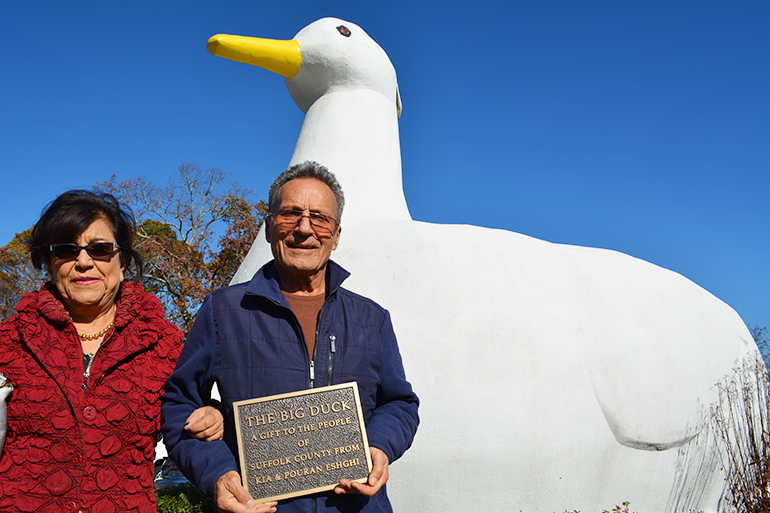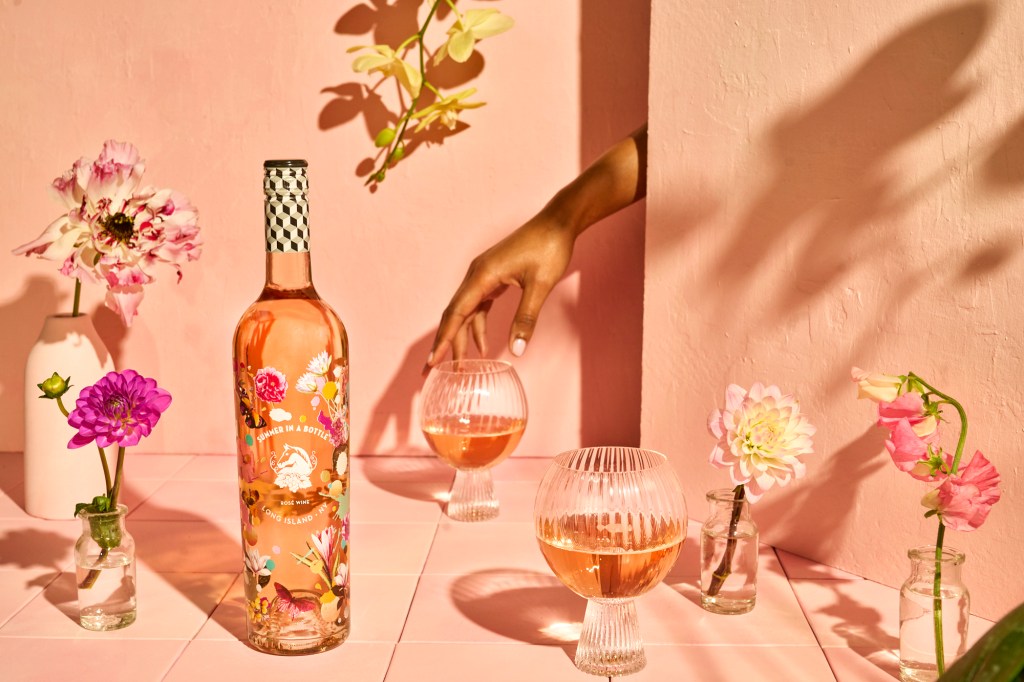The Big Duck: Pouran and Kia Eshghi’s Gift to the East End

The Big Duck stands as one of the most iconic structures on the East End, nested comfortably on Route 24, making it impossible to miss on one’s way between the Hamptons to the North Fork. Commissioned by duck farmer Martin R. Maurer in 1931, the now-famous building has passed through many hands since its creation, ultimately ending up in the possession of Suffolk County by way of a generous donation from Kia and Pouran Eshghi. With nearly a century’s worth of history, the Big Duck’s story is often told in summary, capturing only bits and pieces of each chapter in its “life,” but to merely bullet-point the Eshghi’s section would be to miss out on the immense sentimentality of purchasing it, the fantastical dreams of what to do with it and the initial pain of letting it go.
After emigrating from Iran in the 1960s, the Eshghis settled on Long Island, often visiting the Hamptons with their two daughters. On one trip, Kia remembers driving past the Big Duck for the first time and exclaiming, “Look at that! Let’s go see what’s inside!” He continues, “As an artist who does sculpture and painting, I look at it as a piece of art. Then, we saw the guy cooking inside, making rotisserie duck, and we loved it!”

By the 1980s, the Eshghis were looking to purchase a summer home in the Hamptons, making sure to stop by the Big Duck on every visit. When the real estate agent who eventually helped them find their house on Tiana Bay informed them that their beloved landmark was for sale, they purchased it without a moment’s hesitation. “We only bought it sentimentally, not looking at it as a business,” Pouran recalls. “We were very attached to it, and our children were very attached to it.”
Mario and Jean Colombo signed over the Big Duck Ranch, and its signature white fowl, to the Eshghis in 1982. After some property cleanup and repairs, the Eshghis reopened the Big Duck to sell rotisserie chicken and duck once more, using the original recipe passed on to them by the Colombos. “On the Fourth of July and in the summer, people came and bought 20 or 30 ducks for their parties, and it was very nice,” Pouran says. “It wasn’t something we looked at as a really good business, but it paid for the expenses to keep running it.” Kia adds that their client list included other well-known South Fork establishments, such as the former Hampton Bays Diner, which served Big Duck dishes regularly.
The next year, Kia and Pouran’s schedule become truly hectic. “I was doing a lot of exhibits and galleries, and my wife was very much involved with her salon and spa. Then she asked me to open up a designer boutique for her,” Kia explains. “We were extending ourselves so many places! Then, also in 1983, our son was born.”
Despite having less time to devote to the Big Duck, the Eshghis had big dreams to evolve it in ways that would’ve completely changed the landmark’s role on the East End today. Kia’s plan was to turn the ranch into an art colony and shopping center where local artists could live for the monthly cost of one finished sculpture or painting. “Who’s going to pass on something like that—especially in the Hamptons?” Kia exclaims. “A lot of people want to rent a room, but cannot afford it.” Sadly, turning Big Duck Ranch into affordable housing for artists required a mountain of permits and variances that weren’t so easily granted, leaving the idea at an impasse. “In my head, the only thing I missed during that time, was that dream,” he admits.
Pouran had a radically different vision for the Big Duck that would have seen it duplicated, with franchises selling rotisserie duck on the East End and beyond. They created Big Duck Landmark, Inc. for that very purpose, but that’s as far as the potentially lucrative concept got.
They ultimately decided to sell Big Duck Ranch to a real estate developer and donate the Big Duck itself to Suffolk County, though their initial intent was to sell that, as well. “We said we want $500,000 for it, and Suffolk County told us they can’t give that kind of price,” Pouran explains. After talking things over with Suffolk County Division of Historic Services director J. Lance Mallamo and Friends for Long Island’s Heritage president Jerry Kessler, as well as seeing the community come together to “Save the Big Duck,” she and Kia realized that, for the sake of the Duck they cherished so much, it was best to donate it to Suffolk. “It was something that was very sentimental for us to buy, and when something is sentimental and you lose it or have to sell it, it doesn’t feel that good,” Pouran recalls. “But later on, it sat with us what a good thing we did to donate it and not sell it, especially to the government, because we know they’ll take good care of it…Believe me, it was better than selling it and getting the money. The satisfaction was much more.”

The deal was struck in December of 1987 with several conditions set by the Eshghis—the Big Duck was to be administered as a historic landmark through Suffolk’s Division of Cultural and Historic Services, the rights to the “Big Duck” trademark remained with the Eshghis, a plaque would be created to indicate that the Duck was a gift from them, and the structure had to be moved off the sold Flanders property by the end of January. Suffolk followed through, moving the Big Duck to Sears Bellows County Park in Hampton Bays. By 2001, the owner of Big Duck Ranch had yet to develop the property, so Southampton Town purchased the land, later working out a deal with Suffolk County to allow the Duck to migrate back to its Flanders home in 2007. “It was a very good transaction between them,” Kia says. “There was a big ceremony—all the big TV stations and newspapers came. It was fun moving it.”
Today, Suffolk owns the Big Duck, now a gift shop, and 10 feet around it, while Southampton owns the rest of Big Duck Ranch, which contains a duck farming exhibit and museum. The ranch, a landmark on the National Register of Historic Places, brings in thousands of visitors and selfie-takers each year and continues to tell the history of East End duck farming and of the Big Duck, including the Eshghis’ fascinating chapter. “Everything that we’ve done for the Duck came with a lot of feelings. Our family loved the Duck,” Kia says, noting that his grandson is the fowl’s newest fan. “Sometimes in life, there comes an opportunity to become part of a little thing that is bigger than life. I think that’s what the Big Duck is [for us].”
The Big Duck isn’t entirely in the Eshghis’ past though, as they try to keep up to date with all of its happenings. “We’d love to get back involved with it,” Pouran says. “We know we can make it different—a little more active.” Kia adds, “The future of the Duck is very big!”
Join the Friends of the Big Duck for the Lighting of the Big Duck at 1012 Route 24, Flanders on Wednesday, December 4 at 7 p.m. Call 631-852-3377 or visit bigduck.org for more info.




